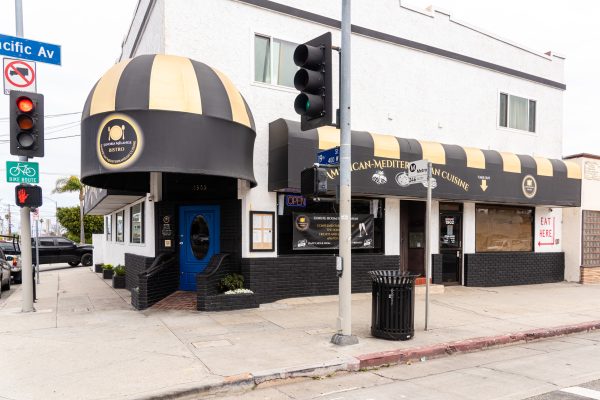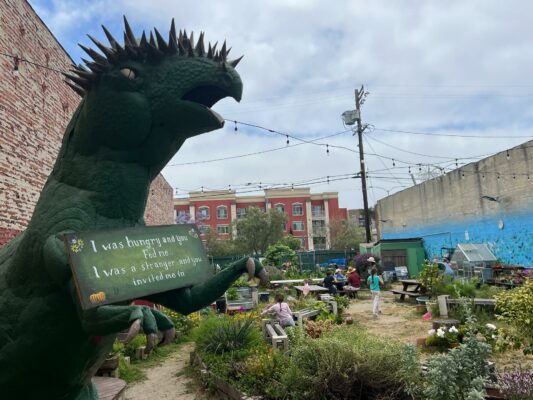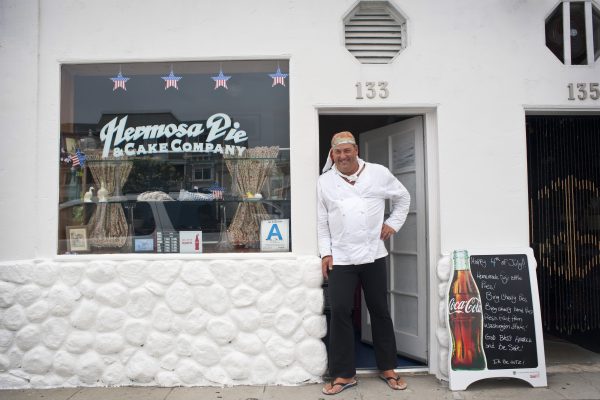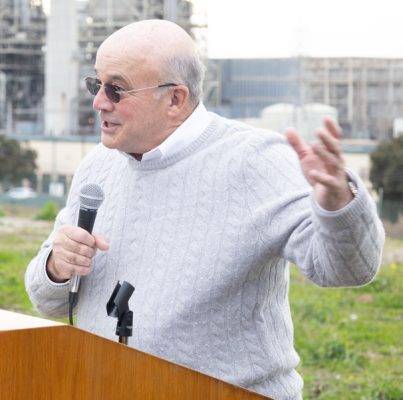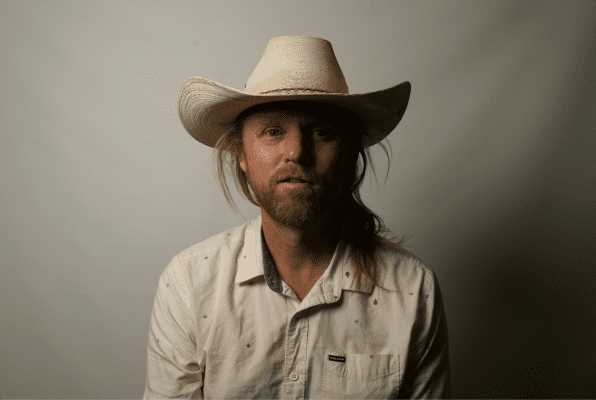
There’s a slight difference of opinion as to the genesis of “The Art & Photography of Robi Hutas,” on view through Sunday at 608 North in Redondo Beach. The exhibition spans decades and includes a range of media in addition to the photography that Hutas is best known for.
“I don’t think a lot of people realize Robi’s talent with watercolors and acrylics,” says gallery owner Kevin Holladay. “We’re trying to highlight the volleyball stuff a little bit, but we just have so much (of Hutas’ work) that I wanted to get it out there and remind people that’s it’s here.”
This sounds very noble and altruistic, bringing attention to an iconic local artist and photographer.
“Actually, he felt sorry for me,” Hutas says, cutting in. “That’s how it started. I had to move, right? My garage door is open, and it’s full of shit. I mean, packed – 47 years of garbage. Full of posters and photography. And you know what? I almost threw everything away.”
Holladay, who is also a general contractor and has a truck, happened to come by, and he saved the day – and a whole lot more besides. Hutas, however, has only kind words for the real estate management company that booted him out of the apartment building in Hermosa Beach where he’d lived for so long: “They’re a bunch of scum.”

Once gone, gone forever
One is tempted to ask Hutas for the juicy details about his rumored affairs with Marilyn Monroe and Jayne Mansfield, but somehow the conversation got around to the Lady Alexandra instead, a poor man’s Queen Mary that was moored in King Harbor for a couple of years until it slid over on its side, was towed out to sea, and became a fish hotel.
Hutas took pictures of the Lady Alexandra and lots of other things – like buildings and even entire streets – that no longer exist in the South Bay. Even so, the fact that he photographed what he did wasn’t the result of having a secure income, a detailed itinerary, and the luxury to indulge in an expensive hobby. It was because… well, here’s how he explains it:
“To be honest with you, if I would have had money I probably wouldn’t have thought of it. I had no place to go, you see? Because I was broke. I could barely eat. I was making less than minimum wage. This is back in 1958.
“In 1958,” Hutas continues, “I couldn’t speak any English, not that much. A friend of mine helped me – what to do, how to ask for things: Give me a buck’s worth of regular instead of I have dollar, you put.” He laughs, and we laugh, and it all seems pretty funny now.

COURTESY 608 North
When Hutas was three or four years old, the world decided it was time for another big war. Born in Budapest, Hungary, in 1936, Hutas must never have been far removed from the deadliest maelstrom of the past century. When the Hungarian people revolted against the Soviet Union in 1956 Hutas said sayonara and made his way across Europe and over to the United States, where he arrived early in 1957.
Even if his English really was along the lines of “I have dollar, you put,” he was smart enough not to settle down in South Dakota or Wisconsin, but to find a place only a block or two from the Strand in Redondo Beach. But apart from being able to spare a quarter for a movie at the old Fox Redondo, what were his options?
“What am I gonna do on the weekend?” Hutas says of those long-ago days. “And so I figured, okay, Redondo Beach is tearing down all these beautiful old buildings: It would be nice to take a picture. That’s how I started. I had a Minolta SR-7, and I photographed Redondo Beach when the old buildings were still there. Little by little, they were taking them down.
“That’s how the whole thing kind of started,” he says once more.

“There’re so many people,” adds Holladay, “that say, Aw, I wish I’d taken a picture of that – right after it’s gone. And he did it.”
“I had that feeling like it’s not gonna be here anymore,” Hutas says.
But he again insists that he didn’t necessarily have posterity in mind when he first began documenting the big changes.
Those big changes were just east and north of the Redondo Pier, roads and businesses and apartments demolished for a crapload of condos that was one of the worst urban planning misfires in South Bay history.
Hutas dismisses the notion that there’s a latent interest in looking at those old pictures. Like, who cares?
“People aren’t so much into this stuff anymore,” Holladay says, “but maybe it’s because they’re not seeing it.”
But Hutas didn’t just photograph street corners and buildings trembling before the wrecking ball. He’s got great pictures from the storm of 1983 that sent fish and seaweed all the way up to the shopfronts along the Strand in Hermosa and well over the breakwater in Redondo Beach. And then, of course, his photographs of volleyball tournaments go back to the 1970s and ‘80s when players weren’t sponsored by big corporations but competed for cheap trophies and pitchers of beer.

COURTESY 608 North
That was back when Hutas was living in a bungalow one block from the ocean in Manhattan Beach and paying just $40 a month in rent.
So how many photographs does he think he’s taken during all this time? He’s 77-years-old now, so let’s do some math.
“Well, if you add them up,” Hutas replies, “maybe a million, 900 thousand, something like that.”
“We’d really like to find a home for those images, somebody who could archive them,” Holladay says.
Is anyone going to step up? Hello? Historical societies? Going once, going twice…
“The Art & Photography of Robi Hutas” is the last solo show for Kevin Holladay’s 608 North art gallery. There’s a final group show that opens on Friday, Dec. 5, and it runs through Sunday, Dec. 28. After that, the doors close for good.
“We just ran out of money,” Holladay says.
In the meantime, some 100 works by Robi Hutas are on view through through Sunday. 608 North is located at 608 N. Francisca Ave., Redondo Beach. (310) 376-5777.


